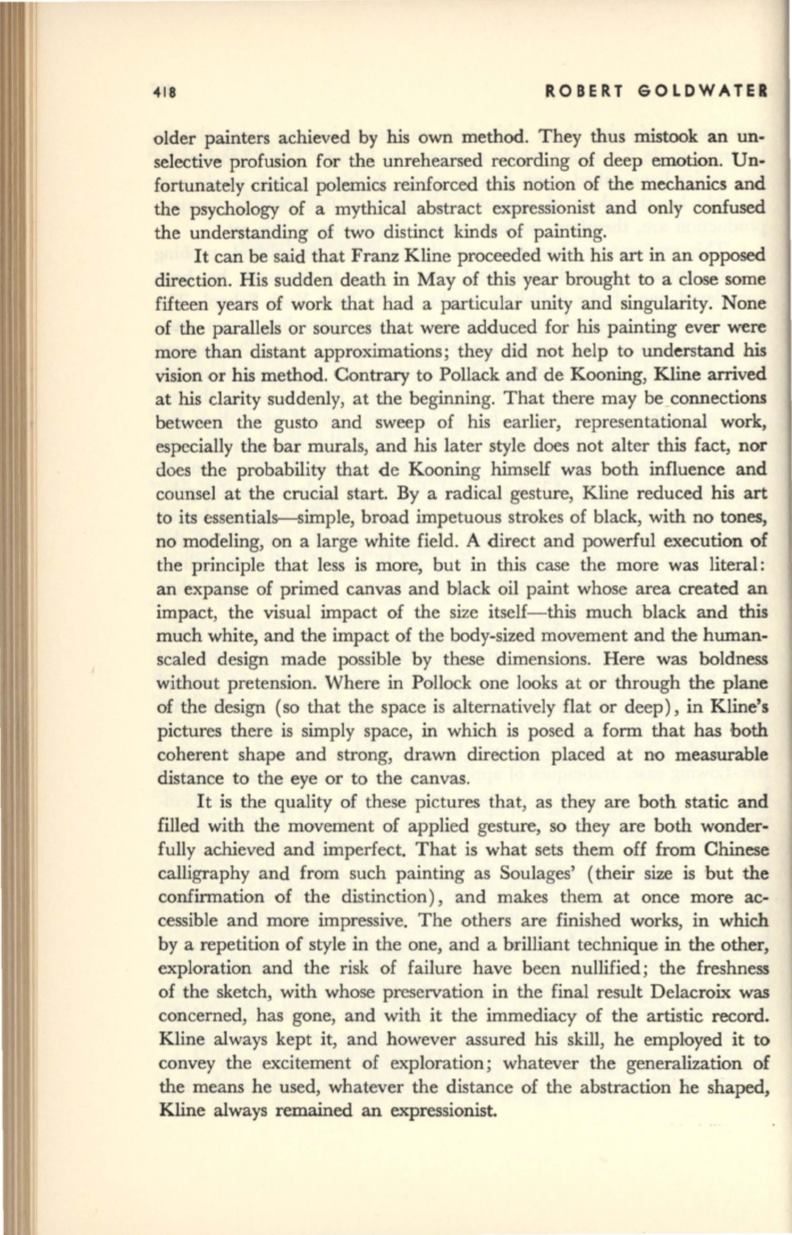
418
ROBERT GOLDWATER
older painters achieved by his own method. They thus mistook an un–
selective profusion for the unrehearsed recording of deep emotion. Un–
fortunately critical polemics reinforced this notion of the mechanics and
the psychology of a mythical abstract expressionist and only confused
the understanding of two distinct kinds of painting.
It can be said that Franz Kline proceeded with his
art
in an opposed
direction. His sudden death in May of this year brought to a close some
fifteen years of work that had a particular unity and singularity. None
of the parallels or sources that were adduced for his painting ever were
more than distant approximations; they did not help to understand his
vision or his method. Contrary to Pollack and de Kooning, Kline arrived
at his clarity suddenly, at the beginning. That there may be connections
between the gusto and sweep of his earlier, representational work,
especially the bar murals, and his later style does not alter this fact, nor
does the probability that de Kooning himself was both influence and
counsel at the crucial start. By a radical gesture, Kline reduced his art
to its essentials--simple, broad impetuous strokes of black, with no tones,
no modeling, on a large white field. A direct and powerful execution of
the principle that less is more, but in this case the more was literal:
an expanse of primed canvas and black oil paint whose area created an
impact, the visual impact of the size itself- this much black and this
much white, and the impact of the body-sized movement and the human–
scaled design made possible by these dimensions. Here was boldness
without pretension. Where in Pollock one looks at or through the plane
of the design (so that the space is alternatively flat or deep), in Kline's
pictures there is simply space, in which is posed a form that has both
coherent shape and strong, drawn direction placed at no measurable
distance to the eye or to the canvas.
It is the quality of these pictures that, as they are both static and
filled with the movement of applied gesture, so they are both wonder–
fully achieved and imperfect. That is what sets them off from Chinese
calligraphy and from such painting as Soulages' (their size is but the
confirmation of the distinction), and makes them at once more ac–
cessible and more impressive. The others are finished works, in which
by a repetition of style in the one, and a brilliant technique in the other,
exploration and the risk of failure have been nullified; the freshness
of the sketch, with whose preservation in the final result Delacroix was
concerned, has gone, and with it the immediacy of the artistic record.
Kline always kept it, and however assured his skill, he employed it to
convey the excitement of exploration; whatever the generalization of
the means he used, whatever the distance of the abstraction he shaped,
Kline always remained an expressionist.


